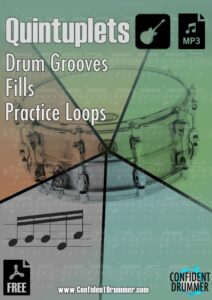I find extremely interesting the way in which rhythmic subdivisions determine the meaning of what we play. As drummers, we are conventionally taught to use only the two main realms of contemporary rhythm: binary and ternary.
The first group includes 8ths,16ths, 32nds and so on. And in the second we find 8th/16th/32nd note triplets, sextuplets and even ninetuplets. Everything we play is related to those two fundamental ways of perceiving a beat: groups of two, or groups of three.
Recently some new forms of approaching subdivisions have become more and more used by drummers. Until a few years ago, quintuplets and septuplets could only be found in music theory books, or in Frank Zappa compositions 🙂 (and yes, in classical music).
Quintuplets are the coolest thing when it comes to fresh sounding and compelling modern beats and fills. Like triplets, they are irregular note groupings, also known as ‘tuplets’.
A tuplet is nothing other than a rhythm that involves dividing the beat into a number of equal subdivisions that is different from what’s permitted by regular music notation.
Just like there’s no symbol that can represent a third of a quarter note, and so we are all familiar with triplets and borrowing the eighth note figure, we can only notate quintuplets by adding a bracket on top of the five note grouping. The same principle can be applied to septuplets, ninetuplets and so on.
So, the theory behind quintuplets is pretty simple. We divide the pulse, a quarter note, in five identical parts. The musical implications of this, however, are incredible.
The most popular application of quintuplets is probably Swag Feel or Drunk Feel beats. Swag drumming, also known as Dilla Feel is an approach to playing drums that places notes on unconventional and seemingly ‘out of time’ grids.
If you are familiar with drummers like Chris Dave, Adam Deitch or Questlove, you know what I’m talking about. It just so happens that quintuplets are a great way to position these notes on a correct grid, which allows for the consistency we like when listening to music, while still generating this drunk feel (it’s a little more nuanced than this, because actually we can play ‘in between the cracks’ with no proper grid, using different swing feel levels).
Also septuplets are used to achieve the same result, although quintuplets remain the favourite approach.
This is the classic situation in which we learn something the best by hearing, watching and doing it. That’s why we are going to dive right into this booklet, which contains 32 examples:
– 8 basic cells to quickly familiarize with this subdivision.
– 16 grooves.
– 8 fills.
– A jam along 8 bar loop that you can use, at various tempos, to practice and improvise.
Here is the download:
Playing along with loops is a very effective way to learn many aspects of music, and here we are going to use this approach to internalize this unique rhythm and quickly start feeling comfortable playing quintuplets, even if it’s the first time that we do it.
At the beginning of this YouTube video demo I play through the 8 bar loop, changing mode every 4 bars for a couple of minutes, to give you a taste of how these ideas sound when mixed and applied musically.
In the audio downloads you are going to find four files. A GarageBand ready to use session, so that you can modify the loop, change its tempo, mix each instrument how you want, and even record your performance.
For those of you that don’t use GarageBand I have included three Mp3s, at three different tempos. Each file is a five minute long audio that you can play along with, to practice the examples included in the PDF, and also to start improvising.
Related resources:
‘Groove Mastery & Formulas’ – Altitude Drumming – Volume 8



















